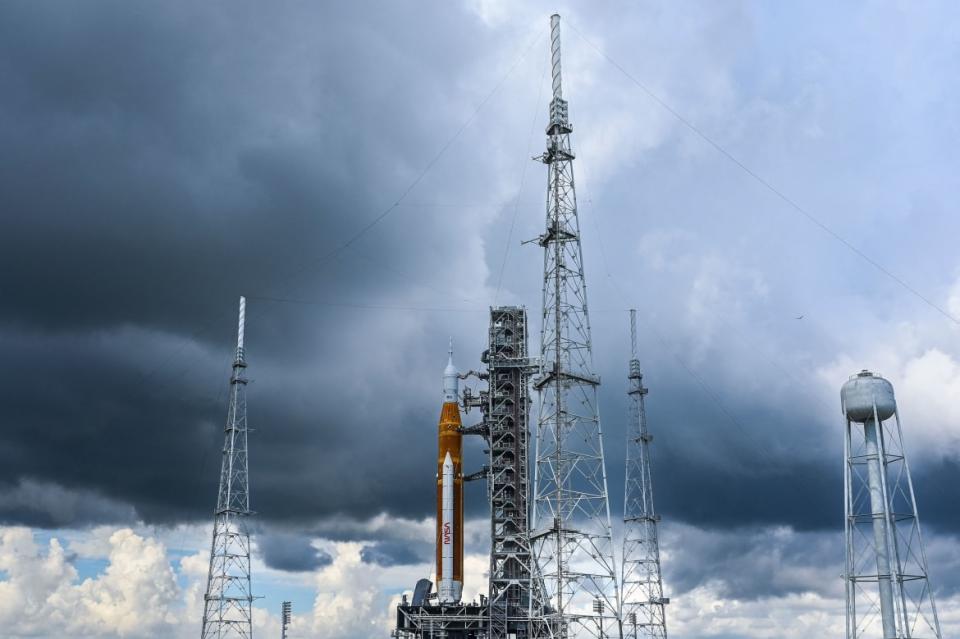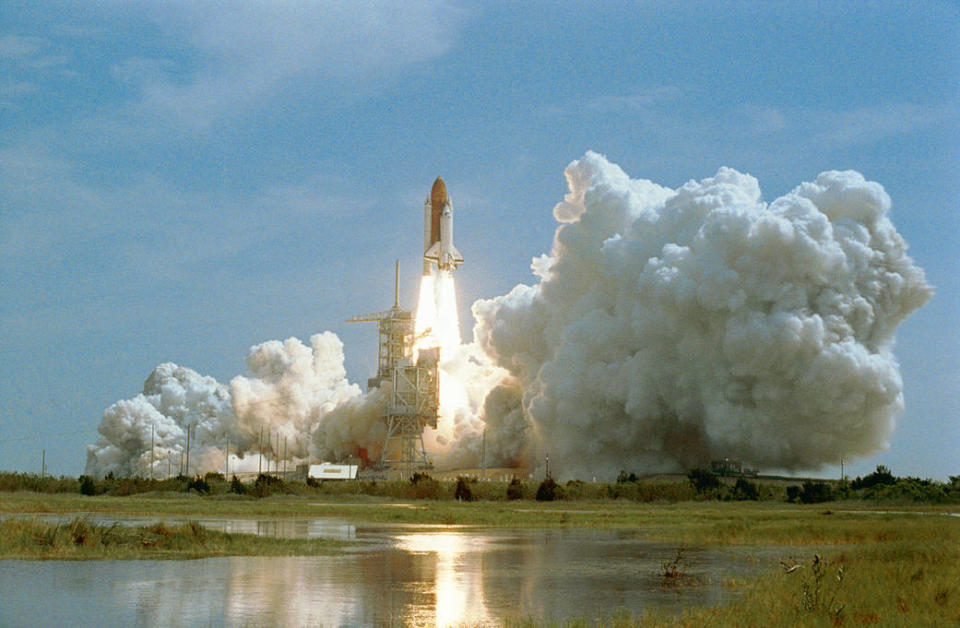Why Is Returning to the Moon So Damn Difficult for NASA?

Artemis—the goddess of the hunt in Greek mythology—is the twin sister of Apollo, the god of the sun. But when it comes to their respective NASA programs, the difference between the two couldn’t be more stark.
Take Artemis, for example. After much ballyhoo and fanfare—including planned appearances by the likes of Chris Evans, Jack Black, and Keke Palmer—the Artemis 1 launch scheduled for Aug. 29 went off with neither a bang nor a whimper. Instead, it just didn’t go off. The massive Space Launch System (SLS) rocket sat on the launch pad after being scrubbed for a technical issue involving a liquid hydrogen leak. In fact, another fueling glitch reared its ugly head last Saturday when it was rescheduled to launch.
That brings us to this week. NASA has announced that it will spend an extended amount of time troubleshooting the enormous rocket, which means that the earliest chance for Artemis to launch will be from Sept. 19 to Oct. 4, due to the orbital trajectory. Given the distinct possibility that the SLS will need to be taken off the launch pad and for more extensive repairs, a likelier launch window is sometime between Oct. 17 and Oct. 31.

The Artemis I rocket sits on the launch pad at Kennedy Space Center in Cape Canaveral, Florida, on Aug. 26, 2022, ahead of its scheduled launch on Aug. 29.
And this is just the latest in a long line of delays that have plagued the beleaguered SLS since its inception in 2010 during the Obama administration (back when the plan was to skip the moon and shoot straight for Mars). NASA also has drawn criticism due to what’s been viewed as mismanagement of its private contractors over the course of the project resulting in the pesky delays.
All this begs the question: Why is it so goddamn hard to get a rocket to the moon nowadays? The Apollo missions took place half a century ago and saw more success getting astronauts to the lunar surface despite the fact that they used more archaic technology. Whereas Tony Stark built the Iron Man suit in a cave with a box of scraps, NASA built the Apollo program out of whole cloth. Heck, the cellphone or computer you’re reading this story on is more powerful than the computers used back then.
Artemis 1, meanwhile, is supposed to feature a state-of-the-art spacecraft called Orion that could eventually go to Mars. SLS is supposed to be the biggest rocket ever built. The inaugural launch isn’t even crewed—it’s just supposed to be an empty test flight. Why, with all the resources and technological advances that we have now, can we not get a rocket into the air to just orbit the moon?
“The job of getting SLS up off the ground is a lot more complicated than getting the Apollo missions off the ground,” John Logsdon, a professor emeritus of space policy at George Washington University, told The Daily Beast. “You have to do everything that was involved with the Apollo mission and also deal with the liquid hydrogen fuel.”

NASA completed six crewed missions to the moon and landed 12 astronauts over the course of the Apollo missions.
The hydrogen fuel Logsdon referred to is the exact thing that caused the Monday and Saturday launches to be scrubbed. The issue lies in the fact that hydrogen is the lightest and smallest element in the known universe. The tiny element means a lighter payload for the rocket, resulting in greater launch efficiency. However, it also results in bigger problems—namely, it easily escapes from any openings or cracks.
In both of last week’s launch attempts, the liquid hydrogen began leaking near a tool called the quick disconnect that helps fuel the SLS. This, in and of itself, isn’t a major problem if it’s a small amount of leakage. However, the amount it was leaking was “two or three times” higher than the amount NASA would tolerate, Artemis 1 mission manager Mike Sarafin said in a statement seen by Ars Technica. “Every time we saw a leak, it pretty quickly exceeded our flammability limits.”
Compare that to the Apollo, which used a Saturn V rocket to get to space. That launch system used a fuel that was “basically airplane fuel,” Logsdon explained. “It was a form of kerosene as the propellant.”
The reason we’re using liquid hydrogen at all despite it being so difficult to work with goes back to the SLS’s design: Its core propulsion system has been built using old and used parts from the Space Shuttle program. You know, the spacecraft NASA launched from 1981 to 2011. That’s more than ten years since it’s ended.
The Space Shuttles also frequently encountered delays and mission scrubs due to the liquid hydrogen issue. “SLS’s delay is a consequence of the choice of using Shuttle engines,” Logsdon said. “That means you have to use Shuttle fuel: liquid hydrogen, which is finicky to use.”
As for why NASA decided to use old museum-piece tech to launch the next generation of space exploration, the reason goes back more than a decade, to when Congress signed off on funding for the SLS’s creation. Under these guidelines, the agency was required to use “contracts, investments, workforce, industrial base, and capabilities from the Space Shuttle and Orion and Ares 1 projects.” This included, of course, the old engines and fueling system.
The idea was likely that it would be cheaper if we just cobbled together a new rocket using parts from an old one—a sort of Frankenstein launch system that would take astronauts beyond Earth’s orbit once again. Unlike the monster, though, this one’s struggling to get up and going. In the end, the Congressional act passed to fund the SLS has ended up being more of an albatross around NASA’s proverbial neck (not to mix our metaphors).
So the SLS—the very rocket that is supposed to take us back to the moon—is kind of a crappy rocket. However, Logsdon also pointed out that another big driver behind the Artemis mission’s persistent headaches are fundamental cultural issues that separate it from the Apollo program.

NASA launched the Space Shuttle from 1981 to 2011. Now its engines are being used to power the Space Launch System more than a decade after the last Shuttle launch.
After all, when we first took astronauts to the moon, the U.S. was in the throes of the Cold War. NASA was created largely in response to the fact that the Soviet Union’s space program already sent Sputnik into space. It needed a big win in the cosmos if it wanted to “win” the space race.
“There was an intensity in the Apollo program because of the end-of-the-decade deadline and because we were racing the Soviet Union that is not present now,” Logsdon said. He added that this meant Apollo could be a “crash program,” which resulted in more funding and resources for the fledgling NASA.
And, most controversially, Logsdon suggested that the people involved with the Apollo program might have been just a bit more talented too. That’s partially a result of the fact that more than 400,000 people were involved in getting us to the moon the first go around. While NASA doesn’t have publicly available data on how many people are involved with the SLS, it’s very likely less than that, Logsdon speculated.
It also doesn’t help that NASA has to rely on private companies that have routinely drawn criticism for both underperforming and missing key deadlines.
“The people working on Artemis may not be as good as the people who worked on Apollo,” Logsdon said. “There’s been a lot of criticism particularly of Boeing and its performance with respect to SLS. Some NASA Inspector General reports have been critical about the quality of Boeing’s performance and, to some degree, NASA’s oversight of that performance.”
And that brings us to now. The U.S. space program has a massive sunk cost fallacy sitting on the coast of Florida that NASA needs to get into space if it wants to return astronauts to the moon and, eventually, go farther. After all, if we ever want to reach the lofty goals of becoming a multi-planetary species, that starts with reaching the moon.
Luckily, we have some of the best minds working on it as you read this. One way or another, the hydrogen fuel leaking issue will be solved. It might take even more delays and funding, but it will get done. If history has shown us anything, we’re very good at learning from our mistakes—at least when it comes to space travel.
“One thing to remember is that the first launch of the Space Shuttle was scrubbed,” Logsdon added. “Space is hard. Once we get the launch of Artemis 1 off the pad, the next one will likely go smoother.”
Got a tip? Send it to The Daily Beast here
Get the Daily Beast's biggest scoops and scandals delivered right to your inbox. Sign up now.
Stay informed and gain unlimited access to the Daily Beast's unmatched reporting. Subscribe now.

